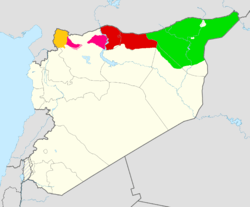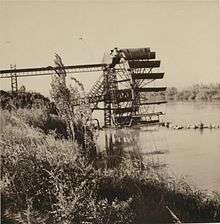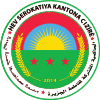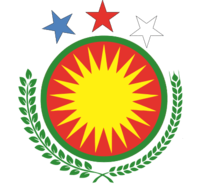Jazira Canton
| Jazira Canton | |||
|---|---|---|---|
| One of three de facto autonomous cantons of the region of Rojava in Syria | |||
| |||
 The three cantons of Rojava: Afrin Canton (orange), Kobanî Canton (red), Jazira Canton (green), and the Shahba region (pink) | |||
| Country |
| ||
| Governorate | Al Hasakah | ||
| De facto Administration | Federation of Northern Syria - Rojava | ||
| Autonomy declared | January 21, 2014 | ||
| Administrative center | Al-Qamishli | ||
| Government | |||
| • Prime Minister | Akram Hesso | ||
| • Co-Vice President | Elizabeth Gawrie | ||
| • Co-Vice President | Hussein Taza Al Azam | ||
| Population | |||
| • Estimate (2011[1]) | 1,512,000 | ||
| Time zone | EET (UTC+2) | ||
| • Summer (DST) | EEST (UTC+3) | ||
| Area code | +963 52 | ||
| Official languages | Kurdish, Arabic and Syriac-Aramaic | ||

Jazira Canton (Kurdish: Kantona Cizîrê, Arabic: مقاطعة الجزيرة, Syriac: ܟܢܛܢ ܓܨܪܛܐ Canton Gozarto) is the largest of four cantons of the de facto autonomous Kurdish region of Rojava in Northern Syria. As part of the ongoing Rojava campaign, its democratic autonomy was officially declared on 21 January 2014.[2] The canton was established on the Al-Hasakah Governorate formerly known as Al-Jazira province of Syria.
According to the constitution, the city of Al-Qamishli is the administrative center of Jazira Canton.[3] However, as parts of Al-Qamishli remain under the control of Syrian government forces, meetings of the autonomous canton's administration take place in the nearby city of Amuda.[2]
Geography
Jazira Canton encompasses the area of Al-Hasakah Governorate except for the Markadah Nahiyah of the Al-Hasakah District at the southernmost tip and Nahiya Ras al-Ayn of the Ras al-Ayn District at the westernmost tip. The canton is bordered by Mardin and the western part of Şırnak Provinces of Turkey to the north, and Iraqi Kurdistan to the east.
Demographics
Jazira Canton's population is ethnically composed of Kurds, Arabs, Assyrians, Armenians and Yazidis. While Kurdish, Arabic and Syriac-Aramaic are official languages, all communities have the right to teach and be taught in their native language. Religions practiced in the canton are Islam, Christianity and Yazidism.[3] Between 20-30% of the people of the canton are Christians of various churches and denominations.[4]
Cities and towns with more than 10.000 inhabitants according to the 2004 Syrian census are Hasakah (188,160), Qamishli (184,231), Ras al-Ayn (29,347), Amuda (26,821), Al-Malikiyah (26,311), Al-Qahtaniyah (16,946), Al-Shaddadah (15,806), Al-Muabbada (15,759), Al-Sabaa wa Arbain (14,177) and Al-Manajir (12,156).
History
During the Ottoman Empire (1299–1922), large Kurdish-speaking tribal groups both settled in and were deported to areas of northern Syria from Anatolia. The largest of these tribal groups was the Reshwan confederation, which was initially based in Adıyaman Province but eventually also settled throughout Anatolia. The Milli confederation, mentioned in 1518 onward, was the most powerful group and dominated the entire northern Syrian steppe in the second half of the 18th century. Danish writer C. Niebuhr who traveled to Jazira in 1764 recorded five nomadic Kurdish tribes (Dukurie, Kikie, Schechchanie, Mullie and Aschetie) and six Arab tribes (Tay, Kaab, Baggara, Geheish, Diabat and Sherabeh).[5] According to Niebuhr, the Kurdish tribes were settled near Mardin in Turkey, and paid the governor of that city for the right to graze their herds in the Syrian Jazira.[6][7] The Kurdish tribes gradually settled in villages and cities and are still present in Jazira (modern Syria's Hasakah Governorate).[8] The Ottoman province of Diyarbekir, which included parts of modern-day northern Syria, was called Eyalet-i Kurdistan during the Tanzimat reforms period (1839–67).[9] Until the 19th century, Kurdistan did not include the lands of Syrian Jazira in some books.[note 1][10] The Treaty of Sèvres' putative Kurdistan did not include any part of today's Syria.[11] According to McDowall, Kurds slightly outnumbered Arabs in Jazira in 1918.[12]

The demographics of Northern Syria saw a huge shift in the early part of the 20th century when the Ottoman Empire (Turks) conducted ethnic cleansing of its Armenian and Assyrian Christian populations and some Kurdish tribes joined in the atrocities committed against them.[13][14][15] Many Assyrians fled to Syria during the genocide and settled mainly in the Jazira area.[16][16][17][18]
Until the 19th century, Kurdistan did not include the lands of Syrian Jazira in some books.[note 2][10] According to McDowall, Kurds slightly outnumbered Arabs in Jazira in 1918.[12]
Starting in 1926, the region saw huge immigration of Kurds following the failure of the Sheikh Said rebellion against the Turkish authorities.[19] While many of the Kurds in Syria have been there for centuries, waves of Kurds fled their homes in Turkey and settled in Syria, where they were granted citizenship by the French mandate authorities.[20] This large influx of Kurds moved to Syria’s Jazira province. It is estimated that 25,000 Kurds fled at this time to Syria.[21]
In the late 1930s a small but vigorous separatist movement emerged in Qamishli. With some support from French Mandate officials, the movement actively lobbied for autonomy direct under French rule and separation from Syria on the ground that majority of the inhabitants were not Arabs. Syrian nationalists saw the movement as a profound threat to their eventual rule. The Syrian nationalists allied with local Arab Shammal tribal leader and Kurdish tribes. They together attacked the Christian movement in many towns and villages. Local Kurdish tribes who were allies of Shammar tribal sacked and burned Assyrian town of Amuda.[22][23][24] In 1941, the Assyrian community of al-Malikiyah was subjected to a vicious assault. Even though the assault failed, Assyrians felt threatened and left in large numbers, and the immigration of Kurds from Turkey to the area converted al-Malikiya, al-Darbasiyah and Amuda to Kurdish-majority cities.
According to the French report to the League of Nations in 1937, the population of Jazira consisted of 82,000 Kurdish villagers, 42,000 Muslim Arab pastoralists, and 32,000 Christian town dwellers (Assyrians and Armenians).[25]
Between 1932 and 1939, a Kurdish-Christian autonomy movement emerged in Jazira. The demands of the movement were autonomous status similar to the Sanjak of Alexandretta, the protection of French troops, promotion of Kurdish language in schools and hiring of Kurdish officials. The movement was led by Michel Dome, mayor of Qamishli, Hanna Hebe, general vicar for the Syriac-Catholic Patriarch of Jazira, and the Kurdish notable Hajo Agha. Some Arab tribes supported the autonomists while others sided with the central government. In the legislative elections of 1936, autonomist candidates won all the parliamentary seats in Jazira and Jarabulus, while the nationalist Arab movement known as the National Bloc won the elections in the rest of Syria. After victory, the National Bloc pursued an aggressive policy toward the autonomists. The Jazira governor appointed by Damascus intended to disarm the population and encourage the settlement of Arab farmers from Aleppo, Homs and Hama in Jazira.[26] In July 1937, armed conflict broke out between the Syrian police and the supporters of the movement. As a result, the governor and a significant portion of the police force fled the region and the rebels established local autonomous administration in Jazira. [27] In August 1937 a number of Christians in Amuda were killed by a pro-Damascus Kurdish chief.[28] In September 1938, Hajo Agha chaired a general conference in Jazira and appealed to France for self-government.[29] The new French High Commissioner, Gabriel Puaux, dissolved parliament and created autonomous administrations for Jabal Druze, Latakia and Jazira in 1939 which lasted until 1943.[30]
Politics and administration
Legislative Assembly
All four main ethnic communities (Kurds, Arabs, Armenians and Assyrians/Syriacs) are represented in the 101-seat Legislative Assembly.[31] The current prime minister (sometimes referred to as president) of Jazira Canton is the Kurdish Akram Hesso with Arab Hussein Taza Al Azam and Assyrian Elizabeth Gawrie as deputy prime ministers (sometimes referred to as vice-presidents).[32]
There are people's councils but it is unclear how they relate to the transitional government.
Notable legislation
In January 2016, Jazira Canton introduced a "self-defense duty" conscription law for its self-defence forces, including an avoidance fee for residents of age for mandatory military service who have moved to Europe, to pay $200 for each year of absence upon their return.[33]
In September 2015, the legislative council passed the Law for the Management and Protection of the Assets of the Refugees and the Absentees, under which a real estate owner loses title when he does not make personal use of the property. In particular among the Assyrian community in Jazira Canton, persistent opposition was voiced, as their community is disproportionally hit by the measure, for both a high degree of real estate ownership and a particularly high share of outbound civil war refugees.[34] Assyrian organizations of the region published several statements making accusations of seizing private property, demographic changing and ethnic cleansing.[35][34] Assets seized from Assyrians under the law have reportedly since been handed over to Assyrian churches.[34]
Police
Security is maintained by the Asayish police force and its Assyrian counterpart, the Sutoro. Syrian government loyalists only control a number of demarcated neighborhoods in Qamishli.[36]
List of executive officers
| Name | Party | Office | Elected | Notes | |
|---|---|---|---|---|---|
| Akram Hesso | PYD | Prime Minister | 2014 | ||
| Elizabeth Gawrie | SUP | Deputy Prime Minister | 2014 | ||
| Hussein Taza Al Azam | PB-ASD | Deputy Prime Minister | 2014 | ||
| Abulkarim Omer | N/A | Foreign Minister | 2015 | Replaced Salih Gedo | |
| Abdulkarim Sarokhan | N/A | Minister of Defense | 2014 | ||
| Kanaan Barakat | N/A | Interior Minister | 2014 | ||
| Abdulmenar Yoxo | SUP | Minister of Regional Commissions, Councils and Planning |
2014 | ||
| Emziye Muhammed | PB-ASD | Minister of Finance | 2014 | ||
| Dijwar Ehmed Axa | N/A | Minister of Labor and Social Security |
2014 | ||
| Mihemed Salih Abo | N/A | Minister of Education | 2014 | ||
| Abdulmecid Sebri | N/A | Minister of Agriculture Minister of Health |
2014 | ||
| Siham Kiryo | SUP | Minister of Trade and Economy | 2014 | ||
| Rezan Gulo | N/A | Minister of Martyrs’ Families | 2014 | ||
| Mehawan Mihemed Hesen | N/A | Minister of Culture | 2014 | ||
| Mihemed Hesen Ubeyd | N/A | Minister of Transportation | 2014 | ||
| Mihemed İsa Fatimi | N/A | Minister of Youth and Sport | 2014 | ||
| Lokman Ehme | N/A | Minister of the Environment and Tourism |
2014 | ||
| Şex Mihemed Qadiri | N/A | Minister of Religious Affairs | 2014 | ||
| Emine Umer | N/A | Minister of Women and Family Affairs |
2014 | ||
| Senherid Basom | SUP | Minister of Human Rights | 2014 | ||
| Temer Hesen Cahid | N/A | Minister of Industry and Commerce |
2014 | ||
| Salal Mihemed | N/A | Minister of Information and Communication |
2014 | ||
| Abdulhamit Bekir | N/A | Minister of Justice | 2014 | ||
| Süleyman Xelek | N/A | Minister of Electricity, Industry and Natural Resources |
2014 | ||
Economy
Jazira Canton is home several oil fields, among them Syria's best producing at Rmelan. As of late 2016, oil output in Jazira Canton was estimated at around 40,000 barrels per day.[34]
Education
Like in the other Rojava cantons, pimary education in the public schools is initially by mother tongue instruction either Kurdish or Arabic, with the aim of bilingualism in Kurdish and Arabic in secondary schooling.[37][38] Curricula are a topic of continuous debate between the cantons' Boards of Education and the Syrian central government in Damascus, which partly pays the teachers.[39][40][41][42] In August 2016, the Ourhi Centre in the city of Qamishli was founded by the Assyrian community, to educate teachers in order to make the Syriac-Aramaic an additional language to be taught in public schools in Jazira Canton,[43][44] which then started with the 2016/17 academic year.[39] With that academic year, states the Rojava Education Committee, "three curriculums have replaced the old one, to include teaching in three languages: Kurdish, Arabic and Assyrian."[45]
The federal, cantonal and local administrations in Rojava put much emphasis on promoting libraries and educational centers, to facilitate learning and social and artistic activities. One cited example is the 2015 established Nahawand Center for Developing Children’s Talents in Amuda.[46]
The Jazira Canton Board of Education operates two public institutions of higher education, the University of Rojava and the Mesopotamian Social Sciences Academy, both in the city of Qamishli. Jazira Canton houses a third one, the Hasakah campus of Al-Furat University, which is operated by the Damascus government Ministry of Higher Education.
See also
Notes
- ↑ Modern Curdistan is of much greater extent than the ancient Assyria, and is composed of two parts, the Upper and Lower. In the former is the province of Ardelaw, the ancient Arropachatis, now nominally a part of Irak Ajami, and belonging to the north-west division called Al Jobal. It contains five others, namely, Betlis, the ancient Carduchia, lying to the south and south-west of the lake Van. East and south-east of Betlis is the principality of Julamerick—south-west of it, is the principality of Amadia—the fourth is Jeezera ul Omar, a city on an island in the Tigris, and corresponding to the ancient city of Bezabde—the fifth and largest is Kara Djiolan, with a capital of the same name. The pashalics of Kirkook and Solimania also comprise part of Upper Curdistan. Lower Curdistan comprises all the level tract to the east of the Tigris, and the minor ranges immediately bounding the plains, and reaching thence to the foot of the great range, which may justly be denominated the Alps of western Asia.
A Dictionary of Scripture Geography (1846), John Miles.[10] - ↑ Modern Curdistan is of much greater extent than the ancient Assyria, and is composed of two parts, the Upper and Lower. In the former is the province of Ardelaw, the ancient Arropachatis, now nominally a part of Irak Ajami, and belonging to the north-west division called Al Jobal. It contains five others, namely, Betlis, the ancient Carduchia, lying to the south and south-west of the lake Van. East and south-east of Betlis is the principality of Julamerick—south-west of it, is the principality of Amadia—the fourth is Jeezera ul Omar, a city on an island in the Tigris, and corresponding to the ancient city of Bezabde—the fifth and largest is Kara Djiolan, with a capital of the same name. The pashalics of Kirkook and Solimania also comprise part of Upper Curdistan. Lower Curdistan comprises all the level tract to the east of the Tigris, and the minor ranges immediately bounding the plains, and reaching thence to the foot of the great range, which may justly be denominated the Alps of western Asia.
A Dictionary of Scripture Geography (1846), John Miles.[10]
References
- ↑ http://cbssyr.org/yearbook/2011/Data-Chapter2/TAB-3-2-2011.htm
- 1 2 "Al-Qamishli to be capital city of Jazeera Canton in Syrian Kurdistan". Firat News. 26 January 2014.
- 1 2 "The Constitution of the Rojava Cantons". Personal Website of Mutlu Civiroglu.
- ↑ http://www.acaps.org/reports/download/al_hasakeh_governorate_profile_february_2014/76/syria
- ↑ Carsten Niebuhr (1778). Reisebeschreibung nach Arabien und andern umliegenden Ländern. (Mit Kupferstichen u. Karten.) - Kopenhagen, Möller 1774-1837 (in German). p. 419.
- ↑ Kreyenbroek, P.G.; Sperl, S. (1992). The Kurds: A Contemporary Overview. Routledge. p. 114. ISBN 0415072654.
- ↑ Carsten Niebuhr (1778). Reisebeschreibung nach Arabien und andern umliegenden Ländern. (Mit Kupferstichen u. Karten.) - Kopenhagen, Möller 1774-1837 (in German). p. 389.
- ↑ Stefan Sperl, Philip G. Kreyenbroek (1992). The Kurds a Contemporary Overview. London: Routledge. pp. 145–146. ISBN 0-203-99341-1.
- ↑ Jongerden, Joost; Verheij, Jelle (2012). Social Relations in Ottoman Diyarbekir, 1870-1915. BRILL. p. 6. ISBN 9789004225183.
- 1 2 3 4 John R. Miles (1846). A Dictionary of Scripture Geography. Fourth edition. J. Johnson & Son, Manchester. p. 57.
- ↑ David McDowall (2004). A Modern History of the Kurds: Third Edition. p. 137.
- 1 2 David McDowall (2004). A Modern History of the Kurds: Third Edition. p. 469.
- ↑ Hovannisian, Richard G. (2007). The Armenian Genocide: Cultural and Ethical Legacies. Retrieved 11 November 2014.
- ↑ Joan A. Argenter, R. McKenna Brown (2004). On the Margins of Nations: Endangered Languages and Linguistic Rights. p. 199.
- ↑ Lazar, David William, not dated A brief history of the plight of the Christian Assyrians* in modern-day Iraq. American Mespopotamian.
- 1 2 R. S. Stafford (2006). The Tragedy of the Assyrians. p. 24.
- ↑ "Ray J. Mouawad, Syria and Iraq – Repression Disappearing Christians of the Middle East". Middle East Forum. 2001. Retrieved 20 March 2015.
- ↑ Bat Yeʼor (2002). Islam and Dhimmitude: Where Civilizations Collide. p. 162.
- ↑ Abu Fakhr, Saqr, 2013. As-Safir daily Newspaper, Beirut. in Arabic Christian Decline in the Middle East: A Historical View
- ↑ Dawn Chatty (2010). Displacement and Dispossession in the Modern Middle East. Cambridge University Press. pp. 230–232. ISBN 978-1-139-48693-4.
- ↑ McDowell, David (2005). A modern history of the Kurds (3. revised and upd. ed., repr. ed.). London [u.a.]: Tauris. p. 469. ISBN 1850434166.
- ↑ Bat Yeʼor (2002). Islam and Dhimmitude: Where Civilizations Collide. p. 159.
- ↑ Tejel, Jordi (2008). Syria's Kurds: History, Politics and Society. p. 147.
- ↑ Keith David Watenpaugh (2014). Being Modern in the Middle East: Revolution, Nationalism, Colonialism, and the Arab Middle Class. p. 270.
- ↑ McDowell, David (2004). A modern history of the Kurds. Tauris. p. 470.
- ↑ Tejel, Jordi (2008). Syria's Kurds: History, Politics and Society. Routledge. pp. 29, 30, 35.
- ↑ Romano, David; Gurses, Mehmet (2014). Conflict,Democratization, and the Kurds in the Middle East: Turkey, Iran, Iraq, and Syria. Palgrave Macmillan. pp. 88–89.
- ↑ Jwaideh, Wadie (2006). The Kurdish National Movement: Its Origins and Development. Syracuse University Press. p. 146.
- ↑ McDowell, David (2004). A modern history of the Kurds. Tauris. p. 471.
- ↑ Tejel, Jordi (2008). Syria's Kurds: History, Politics and Society. Routledge. p. 36.
- ↑ "Declaration of democratic autonomy in Cizîre canton".
- ↑ Karlos Zurutuza (28 October 2014). "Democracy is "Radical" in Northern Syria". Inter Press Service.
- ↑ {{cite web|url=http://syriadirect.org/news/kurdish-canton-imposes-new-%E2%80%98luxury%E2%80%99-tax-on-residents-living-in-europe/|title=Kurdish canton imposes new ‘luxury’ tax on residents living in Europe|work=Syria:direct}|date=3 February 2016|accessdate=25 September 2016}
- 1 2 3 4 "NO GOING BACK: WHY DECENTRALISATION IS THE FUTURE FOR SYRIA" (PDF). European Council on Foreign Relations. September 2016.
- ↑ "Assyrian leader accuses PYD of monopolizing power in Syria's north". ARA. 23 March 2016.
- ↑ Carl Drott (6 March 2014). "A Christian militia splits in Al-Qamishli". Carnegie Endowment.
- ↑ "Education in Rojava after the revolution". ANF. 2016-05-16. Retrieved 2016-06-10.
- ↑ "After 52-year ban, Syrian Kurds now taught Kurdish in schools". Al-Monitor. 2015-11-06. Retrieved 2016-05-18.
- 1 2 "Hassakeh: Syriac Language to Be Taught in PYD-controlled Schools". The Syrian Observer. 3 October 2016. Retrieved 2016-10-05.
- ↑ "Kurds introduce own curriculum at schools of Rojava". Ara News. 2015-10-02. Retrieved 2016-05-18.
- ↑ "Revolutionary Education in Rojava". New Compass. 2015-02-17. Retrieved 2016-05-10.
- ↑ "Education in Rojava: Academy and Pluralistic versus University and Monisma". Kurdishquestion. 2014-01-12. Retrieved 2016-05-18.
- ↑ "Syriac Christians revive ancient language despite war". ARA News. 2016-08-19. Retrieved 2016-08-19.
- ↑ "The Syriacs are taught their language for the first time". ANHA. 2016-09-24. Retrieved 2016-09-24.
- ↑ "Rojava administration launches new curriculum in Kurdish, Arabic and Assyrian". ARA News. 7 October 2016. Retrieved 2016-10-07.
- ↑ "Kurds establish university in Rojava amid Syrian instability". Kurdistan24. 2016-07-07. Retrieved 2016-07-07.
External links
- Map of majority ethnicities in Syria by Gulf2000 project of Columbia university


